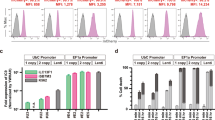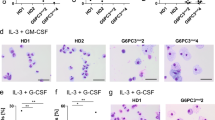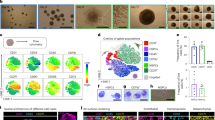Abstract
The generation of induced pluripotent stem (iPS) cells has enabled the derivation of patient-specific pluripotent cells and provided valuable experimental platforms to model human disease. Patient-specific iPS cells are also thought to hold great therapeutic potential, although direct evidence for this is still lacking. Here we show that, on correction of the genetic defect, somatic cells from Fanconi anaemia patients can be reprogrammed to pluripotency to generate patient-specific iPS cells. These cell lines appear indistinguishable from human embryonic stem cells and iPS cells from healthy individuals. Most importantly, we show that corrected Fanconi-anaemia-specific iPS cells can give rise to haematopoietic progenitors of the myeloid and erythroid lineages that are phenotypically normal, that is, disease-free. These data offer proof-of-concept that iPS cell technology can be used for the generation of disease-corrected, patient-specific cells with potential value for cell therapy applications.
This is a preview of subscription content, access via your institution
Access options
Subscribe to this journal
Receive 51 print issues and online access
$199.00 per year
only $3.90 per issue
Buy this article
- Purchase on Springer Link
- Instant access to full article PDF
Prices may be subject to local taxes which are calculated during checkout





Similar content being viewed by others
References
Takahashi, K. & Yamanaka, S. Induction of pluripotent stem cells from mouse embryonic and adult fibroblast cultures by defined factors. Cell 126, 663–676 (2006)
Takahashi, K. et al. Induction of pluripotent stem cells from adult human fibroblasts by defined factors. Cell 131, 861–872 (2007)
Yu, J. et al. Induced pluripotent stem cell lines derived from human somatic cells. Science 318, 1917–1920 (2007)
Park, I. H. et al. Reprogramming of human somatic cells to pluripotency with defined factors. Nature 451, 141–146 (2008)
Lowry, W. E. et al. Generation of human induced pluripotent stem cells from dermal fibroblasts. Proc. Natl Acad. Sci. USA 105, 2883–2888 (2008)
Park, I. H. et al. Disease-specific induced pluripotent stem cells. Cell 134, 877–886 (2008)
Dimos, J. T. et al. Induced pluripotent stem cells generated from patients with ALS can be differentiated into motor neurons. Science 321, 1218–1221 (2008)
Ebert, A. D. et al. Induced pluripotent stem cells from a spinal muscular atrophy patient. Nature 457, 277–280 (2009)
Soldner, F. et al. Parkinson's disease patient-derived induced pluripotent stem cells free of viral reprogramming factors. Cell 136, 964–977 (2009)
Tischkowitz, M. D. & Hodgson, S. V. Fanconi anaemia. J. Med. Genet. 40, 1–10 (2003)
Wang, W. Emergence of a DNA-damage response network consisting of Fanconi anaemia and BRCA proteins. Nature Rev. Genet. 8, 735–748 (2007)
Auerbach, A. D. & Wolman, S. R. Susceptibility of Fanconi’s anaemia fibroblasts to chromosome damage by carcinogens. Nature 261, 494–496 (1976)
Kutler, D. I. et al. A 20-year perspective on the International Fanconi Anemia Registry (IFAR). Blood 101, 1249–1256 (2003)
Guardiola, P. et al. Outcome of 69 allogeneic stem cell transplantations for Fanconi anemia using HLA-matched unrelated donors: a study on behalf of the European Group for Blood and Marrow Transplantation. Blood 95, 422–429 (2000)
Wagner, J. E. et al. Unrelated donor bone marrow transplantation for the treatment of Fanconi anemia. Blood 109, 2256–2262 (2007)
Waisfisz, Q. et al. Spontaneous functional correction of homozygous fanconi anaemia alleles reveals novel mechanistic basis for reverse mosaicism. Nature Genet. 22, 379–383 (1999)
Gregory, J. J. et al. Somatic mosaicism in Fanconi anemia: evidence of genotypic reversion in lymphohematopoietic stem cells. Proc. Natl Acad. Sci. USA 98, 2532–2537 (2001)
Gross, M. et al. Reverse mosaicism in Fanconi anemia: natural gene therapy via molecular self-correction. Cytogenet. Genome Res. 98, 126–135 (2002)
Rio, P. et al. In vivo proliferation advantage of genetically corrected hematopoietic stem cells in a mouse model of Fanconi anemia FA-D1. Blood 112, 4853–4861 (2008)
Liu, J. M. et al. Engraftment of hematopoietic progenitor cells transduced with the Fanconi anemia group C gene (FANCC). Hum. Gene Ther. 10, 2337–2346 (1999)
Kelly, P. F. et al. Stem cell collection and gene transfer in Fanconi anemia. Mol. Ther. 15, 211–219 (2007)
Larghero, J. et al. Hematopoietic progenitor cell harvest and functionality in Fanconi anemia patients. Blood 100, 3051 (2002)
Jacome, A. et al. Lentiviral-mediated genetic correction of hematopoietic and mesenchymal progenitor cells from Fanconi anemia patients. Mol. Ther (in the press)
Ying, Q. L. et al. The ground state of embryonic stem cell self-renewal. Nature 453, 519–523 (2008)
Taniguchi, T. & D’Andrea, A. D. Molecular pathogenesis of Fanconi anemia: recent progress. Blood 107, 4223–4233 (2006)
Almarza, E. et al. Characteristics of lentiviral vectors harboring the proximal promoter of the vav proto-oncogene: a weak and efficient promoter for gene therapy. Mol. Ther. 15, 1487–1494 (2007)
Aasen, T. et al. Efficient and rapid generation of induced pluripotent stem cells from human keratinocytes. Nature Biotechnol. 26, 1276–1284 (2008)
Kalb, R. et al. Hypomorphic mutations in the gene encoding a key Fanconi anemia protein, FANCD2, sustain a significant group of FA-D2 patients with severe phenotype. Am. J. Hum. Genet. 80, 895–910 (2007)
Brivanlou, A. H. et al. Stem cells. Setting standards for human embryonic stem cells. Science 300, 913–916 (2003)
Raya, A. et al. Generation of cardiomyocytes from new human embryonic stem cell lines derived from poor-quality blastocysts. Cold Spring Harb. Symp. Quant. Biol. (in the press)
Pfeifer, A., Ikawa, M., Dayn, Y. & Verma, I. M. Transgenesis by lentiviral vectors: lack of gene silencing in mammalian embryonic stem cells and preimplantation embryos. Proc. Natl Acad. Sci. USA 99, 2140–2145 (2002)
Xia, X., Zhang, Y., Zieth, C. R. & Zhang, S. C. Transgenes delivered by lentiviral vector are suppressed in human embryonic stem cells in a promoter-dependent manner. Stem Cells Dev. 16, 167–176 (2007)
Bogliolo, M. et al. Histone H2AX and Fanconi anemia FANCD2 function in the same pathway to maintain chromosome stability. EMBO J. 26, 1340–1351 (2007)
Nakano, T., Kodama, H. & Honjo, T. Generation of lymphohematopoietic cells from embryonic stem cells in culture. Science 265, 1098–1101 (1994)
Vodyanik, M. A., Bork, J. A., Thomson, J. A. & Slukvin, I. I. Human embryonic stem cell-derived CD34+ cells: efficient production in the coculture with OP9 stromal cells and analysis of lymphohematopoietic potential. Blood 105, 617–626 (2005)
Ji, J., Vijayaragavan, K., Bosse, M., Weisel, K. & Bhatia, M. OP9 stroma augments survival of hematopoietic precursors and progenitors during hematopoietic differentiation from human embryonic stem cells. Stem Cells 26, 2485–2495 (2008)
Okita, K., Ichisaka, T. & Yamanaka, S. Generation of germline-competent induced pluripotent stem cells. Nature 448, 313–317 (2007)
Nakagawa, M. et al. Generation of induced pluripotent stem cells without Myc from mouse and human fibroblasts. Nature Biotechnol. 26, 101–106 (2008)
Okita, K., Nakagawa, M., Hyenjong, H., Ichisaka, T. & Yamanaka, S. Generation of mouse induced pluripotent stem cells without viral vectors. Science 322, 949–953 (2008)
Stadtfeld, M., Nagaya, M., Utikal, J., Weir, G. & Hochedlinger, K. Induced pluripotent stem cells generated without viral integration. Science 322, 945–949 (2008)
Zhou, H. et al. Generation of induced pluripotent stem cells using recombinant proteins. Cell Stem Cell 4, 381–384 (2009)
Gonzalez, F. et al. Generation of mouse-induced pluripotent stem cells by transient expression of a single nonviral polycistronic vector. Proc. Natl Acad. Sci. USA 10.1073/pnas.0901471106 (2009)
Hacein-Bey-Abina, S. et al. Insertional oncogenesis in 4 patients after retrovirus-mediated gene therapy of SCID-X1. J. Clin. Invest. 118, 3132–3142 (2008)
Zwaka, T. P. & Thomson, J. A. Homologous recombination in human embryonic stem cells. Nature Biotechnol. 21, 319–321 (2003)
Casado, J. A. et al. A comprehensive strategy for the subtyping of patients with Fanconi anaemia: conclusions from the Spanish Fanconi Anemia Research Network. J. Med. Genet. 44, 241–249 (2007)
Gonzalez-Murillo, A., Lozano, M. L., Montini, E., Bueren, J. A. & Guenechea, G. Unaltered repopulation properties of mouse hematopoietic stem cells transduced with lentiviral vectors. Blood 112, 3138–3147 (2008)
Bruun, D. et al. siRNA depletion of BRCA1, but not BRCA2, causes increased genome instability in Fanconi anemia cells. DNA Repair (Amst.) 2, 1007–1013 (2003)
Nijman, S. M. et al. The deubiquitinating enzyme USP1 regulates the Fanconi anemia pathway. Mol. Cell 17, 331–339 (2005)
Acknowledgements
The authors are indebted to FA patients and their families for their cooperation. We are grateful to I. Badell, J. Couselo, A. Almeida and D. Schindler for collaboration in providing samples from FA patients, J.A. Casado for subtyping studies, M. Edel, J. Bilic, V. Pekarik and members of the laboratory for comments on the manuscript, J. M. Andrés-Vaquero for assistance with flow cytometry, R. Pujol for assistance with cytogenetics, M. J. Ramirez for immunofluorescence studies, B. Arán, M. Carrió and Y. Muñoz for assistance with cell culture techniques, E. Melo, L. Mulero and M. Martí for bioimaging assistance, and Y. Richaud, T. Lopez Rovira and M. L. Lozano for technical assistance. I.R.-P. and E.S. were recipients of pre-doctoral fellowships from MEC and DIUE, respectively. M.J.B. and G.T. were partially supported by the Ramón y Cajal program, and J.S. by the ICREA-Academia program. This work was partially supported by the Ministerio de Educación y Ciencia grants BFU2006-12251, SAF2005-00058, SAF2006-3440, and Genoma España (FANCOGENE), European Commission ‘Marie-Curie Reintegration Grant’ MIRG-CT-2007-046523 and European Program CONSERT LSHB-CT-2004-5242, the Fondo de Investigaciones Sanitarias (RETIC-RD06/0010/0016, PI061897, PI061099), Marató de TV3 (063430), the G. Harold and Leila Y. Mathers Charitable Foundation, Fundación Marcelino Botín, and Fundación Cellex.
Author information
Authors and Affiliations
Corresponding author
Supplementary information
Supplementary Information
This file contains Supplementary Notes, Supplementary References, Supplementary Tables 1-2 and Supplementary Figures 1-12 with Legends. A missing line from the end of the Supplementary Notes was corrected on 08 October 2009. (PDF 3223 kb)
Supplementary Movie 1
This movie, which is in real-time, shows beating cardiomyocytes differentiated from cFA404-FiPS4F2 cells. (MOV 2312 kb)
Rights and permissions
About this article
Cite this article
Raya, Á., Rodríguez-Pizà, I., Guenechea, G. et al. Disease-corrected haematopoietic progenitors from Fanconi anaemia induced pluripotent stem cells. Nature 460, 53–59 (2009). https://doi.org/10.1038/nature08129
Received:
Accepted:
Published:
Issue Date:
DOI: https://doi.org/10.1038/nature08129
This article is cited by
-
Approaches to characterize the transcriptional trajectory of human myogenesis
Cellular and Molecular Life Sciences (2021)
-
Somatic mosaicism in inherited bone marrow failure and chromosomal instability syndrome
Genome Instability & Disease (2021)
-
Tissue and cell-type-specific transduction using rAAV vectors in lung diseases
Journal of Molecular Medicine (2021)
-
Treating primary immunodeficiencies with defects in NK cells: from stem cell therapy to gene editing
Stem Cell Research & Therapy (2020)
-
TALEN mediated gene editing in a mouse model of Fanconi anemia
Scientific Reports (2020)
Comments
By submitting a comment you agree to abide by our Terms and Community Guidelines. If you find something abusive or that does not comply with our terms or guidelines please flag it as inappropriate.



